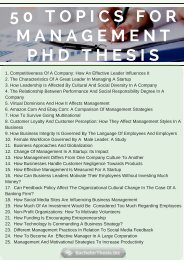Bachelor Thesis Example
Take a look at this article bachelor thesis example https://www.bachelorthesis.biz/wp-content/uploads/2018/02/bachelor-thesis-example.pdf
Take a look at this article bachelor thesis example https://www.bachelorthesis.biz/wp-content/uploads/2018/02/bachelor-thesis-example.pdf
Create successful ePaper yourself
Turn your PDF publications into a flip-book with our unique Google optimized e-Paper software.
B A C H E L O R<br />
T H E S I S<br />
E X A M P L E<br />
OBJECTIVE<br />
DESCRIPTION
S T R A T E G I C A L L I A N C E S<br />
A N D K N O W L E D G E<br />
T R A N S F E R S I N C H I N A<br />
ABSTRACT<br />
Based on a combined methods of approach in drawing an open<br />
and closed question in an online questionnaire, this thesis looks<br />
into exploring knowledge transfers currently undertaken by<br />
Chinese companies as part of their international strategic<br />
techniques. Looking into the importance of these international<br />
strategic alliances in the economy of China. This thesis also seeks<br />
in understanding what the key challenges are involving<br />
knowledge transfers in this setting, what they look like, and how<br />
knowledge may be used in a way that sustains competitive<br />
success.<br />
INTRODUCTION<br />
This chapter outlines the main research context, introducing some<br />
key concepts. To understand the importance and nature of<br />
knowledge transfers, this chapter also defines the meaning of<br />
knowledge that draws on both explicit and tacit forms. Moreover,<br />
it also introduces to the readers the increasing importance of<br />
international strategic alliances, primarily focusing on the<br />
Chinese economy (Carlson, 2006). Recognizing that there is a<br />
connection between competitive success and strategic alliances in<br />
the literature, this research looks on the Chinese market to<br />
understand what these alliances look like, as well as the nature of<br />
knowledge transfers, along with the particular challenges which<br />
exist in this rapidly booming market. This information is required<br />
to assess the overall extent in which Chinese companies can use<br />
the knowledge obtained in order to strengthen their position in<br />
the race.
S T R A T E G I C A L L I A N C E S<br />
A N D K N O W L E D G E<br />
T R A N S F E R S I N C H I N A<br />
LITERATURE REVIEW<br />
This chapter highlights the theoretical basis for the research that<br />
is aligned to the objectives of the research presented. This<br />
chapter further introduces the primary theoretical concepts, as<br />
well as the empirical studies which underpin the arena in which<br />
the research sits.<br />
The point of this exploratory research aims to understand the<br />
depth in which knowledge transfers currently exist in a number of<br />
strategic alliances, as well as the extent in which these underpin<br />
the competitive success. In order for this aspect to be examined,<br />
the meaning of knowledge, as well as the nature of knowledge<br />
transfers should be understood first and foremost.<br />
At a basic level, these knowledge transfer refer to an exchange of<br />
knowledge, which may either be tacit or explicit, and used in<br />
order to further improve learning within the firm. These<br />
knowledge transfers are positioned increasingly as being highly<br />
essential as a result of their being treated as a capacity that<br />
allows organizations to achieve the position of superiority if such<br />
capacity is achieved and focused on (Moran & Philips, 2001).<br />
Different interpretations regarding knowledge and knowledge<br />
transfers are usually generalized and often interpreted as being<br />
ambiguous. This results to discussions regarding knowledge being<br />
coupled with terms including experience, understanding and<br />
intuition which, even though useful, may fail to appreciate the<br />
essence of the context. Knowledge may also be both implicit<br />
which may be based on an experience, and explicit where the<br />
information is translated and depicted easily.
S T R A T E G I C A L L I A N C E S<br />
A N D K N O W L E D G E<br />
T R A N S F E R S I N C H I N A<br />
SUMMARY AND RESEARCH GAPS<br />
The review of literature presented in the next chapter drawing on<br />
the importance of knowledge transfers, and still recognizing how<br />
little attention had been specifically directed towards the nature<br />
of these knowledge transfers in strategic alliances. This often<br />
results in an empirical study was performed so as to identify what<br />
the exchanges actually look like, but also in understanding how<br />
these knowledge transfers may be facilitated because of the<br />
strong empirical linked between innovation, knowledge transfers,<br />
as well as competitive advantage. A foundation and starting point<br />
for this thesis was to further gain clarifications on the concepts,<br />
moving towards a point of exact measurement (Molley, 2002).<br />
References<br />
Carlson, E. (2006). How do social and special proximity impact the<br />
flow of knowledge? Evidences coming from patent data. Urban<br />
Economics Journal, 45(3), 345-367.<br />
Molley, H. (2002). Social research and development methods:<br />
Quantitative and qualitative approaches. California: Sade Press.<br />
Moran, R., & Philips, E. (2001). Strategic modularity in knowledge<br />
transfers: performance and innovation implications. Business<br />
Research of Journal, 34(3), 23-25.













